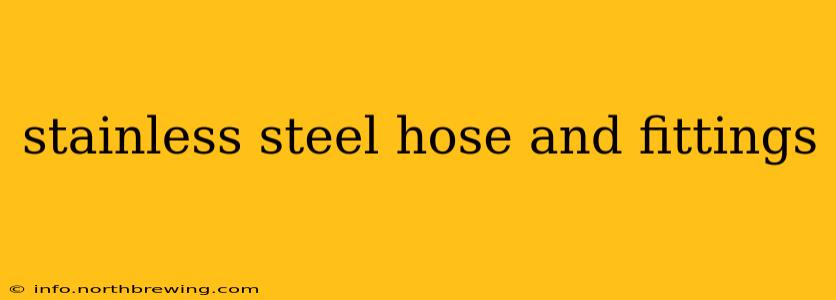Stainless steel hose and fittings are crucial components in various industries, offering superior durability and corrosion resistance compared to other materials. This comprehensive guide explores their applications, types, benefits, and considerations for selection and maintenance. We'll delve into the specifics, answering common questions to provide you with a thorough understanding of this essential industrial equipment.
What are the different types of stainless steel hose and fittings?
Several factors determine the type of stainless steel hose and fittings best suited for a particular application. These include the fluid being conveyed, pressure requirements, temperature fluctuations, and the overall system design. Types of stainless steel hoses include:
- Braided Stainless Steel Hose: This type features a flexible inner tube surrounded by multiple layers of braided stainless steel wire for strength and durability. It's commonly used in applications requiring high pressure and flexibility.
- Corrugated Stainless Steel Hose: Characterized by its flexible, corrugated design, this hose is ideal for applications requiring greater flexibility and resistance to vibration.
- Welded Stainless Steel Hose: This hose is constructed by welding together thin strips of stainless steel, creating a seamless and strong tube. It offers excellent resistance to high pressures and aggressive chemicals.
Fittings, on the other hand, are categorized by their connection type:
- Compression Fittings: These fittings utilize a compression mechanism to secure the hose to the fitting, offering a relatively quick and easy installation.
- Swagelok Fittings: Known for their high-quality and reliability, Swagelok fittings are frequently employed in demanding applications requiring leak-free connections.
- Clamp Fittings: These fittings use a clamp to secure the hose, providing a simple and cost-effective solution, although they may require more frequent inspection and tightening.
The specific grade of stainless steel (e.g., 304, 316) will also influence the hose and fitting's properties and suitability for various environments. 316 stainless steel, for example, offers superior corrosion resistance to 304, making it ideal for marine or chemical processing applications.
What are the benefits of using stainless steel hose and fittings?
The popularity of stainless steel hose and fittings stems from their numerous advantages:
- Corrosion Resistance: Stainless steel's inherent resistance to corrosion makes it ideal for handling aggressive chemicals, saltwater, and other corrosive substances. This extends the lifespan of the system and prevents leaks or failures.
- High Pressure Capability: Stainless steel hoses and fittings can withstand significantly higher pressures compared to alternatives such as rubber or plastic hoses.
- Temperature Resistance: Depending on the grade of stainless steel, these components can withstand a wide range of temperatures, from sub-zero conditions to high heat applications.
- Durability and Longevity: Properly selected and maintained stainless steel hose and fittings offer exceptional longevity, minimizing the need for frequent replacements.
- Cleanliness: Stainless steel is relatively easy to clean and sterilize, making it suitable for applications in the food and pharmaceutical industries.
What are the applications of stainless steel hose and fittings?
Stainless steel hose and fittings find widespread use across diverse industries, including:
- Chemical Processing: Handling corrosive chemicals and solvents.
- Food and Beverage: Transferring liquids and ingredients in hygienic environments.
- Pharmaceutical: Ensuring clean and sterile fluid transfer in drug manufacturing.
- Marine and Offshore: Withstanding harsh saltwater environments.
- Automotive: In fuel and fluid transfer systems.
- Industrial Manufacturing: A wide variety of fluid transfer and process applications.
How do I choose the right stainless steel hose and fittings for my application?
Selecting the appropriate stainless steel hose and fittings requires careful consideration of several factors:
- Fluid Compatibility: Ensure the hose and fittings are compatible with the specific fluid being conveyed, considering its chemical properties, temperature, and pressure.
- Pressure Requirements: The hose and fittings must be rated for the maximum operating pressure of the system.
- Temperature Range: Select components capable of withstanding the expected temperature fluctuations.
- Flexibility Requirements: Consider the degree of flexibility needed for the application.
- Connection Type: Choose fittings that are compatible with the existing system components.
- Budget: Balance cost considerations with performance requirements.
How do I maintain stainless steel hose and fittings?
Regular maintenance is crucial to ensure the longevity and safety of stainless steel hose and fittings:
- Regular Inspection: Visually inspect the hose and fittings for signs of wear, damage, or leaks.
- Tighten Connections: Periodically check and tighten all connections to prevent leaks.
- Clean Regularly: Clean the hose and fittings as needed to prevent contamination.
- Replace Damaged Components: Replace any damaged or worn components promptly to prevent failures.
By understanding the diverse types, benefits, applications, selection criteria, and maintenance requirements, you can effectively utilize stainless steel hose and fittings for optimal performance and longevity in your specific applications. Choosing the correct components from reputable suppliers is essential for ensuring system reliability and safety.
